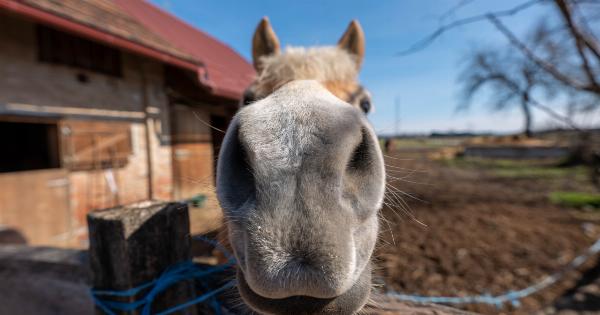Nasal congestion, also known as a stuffy nose, is a common condition that affects people of all ages. It occurs when the tissues lining the nose become swollen and inflamed, leading to difficulty in breathing through the nostrils.
This can be a temporary issue caused by a cold or allergies, or it can be a chronic condition that requires medical intervention. In either case, dealing with nasal congestion can be a frustrating and uncomfortable experience. In this article, we will explore the causes, symptoms, and treatment options for nasal congestion.
Causes of Nasal Congestion
There are several factors that can contribute to nasal congestion. Some of the most common causes include:.
1. Allergies
Allergies are a leading cause of nasal congestion. When the immune system overreacts to allergens such as pollen, dust mites, or pet dander, it releases chemicals that cause inflammation in the nasal passages.
This leads to congestion and difficulty in breathing through the nose.
2. Common Cold
A common cold is another frequent cause of nasal congestion. When you catch a cold, the viral infection causes inflammation in the nasal tissues, leading to congestion and a runny nose.
3. Sinusitis
Sinusitis, also known as a sinus infection, occurs when the sinuses become inflamed and blocked. This can lead to nasal congestion, facial pressure, and headaches.
4. Deviated Septum
A deviated septum is a structural abnormality in which the wall that separates the nostrils is crooked or off-center. This can cause chronic nasal congestion and difficulty in breathing through the nose.
5. Nasal Polyps
Nasal polyps are small growths that develop in the lining of the nose or sinuses. They can obstruct the nasal passages, leading to persistent congestion.
Symptoms of Nasal Congestion
Nasal congestion can be accompanied by various symptoms, including:.
1. Stuffy Nose
The most obvious symptom of nasal congestion is a stuffy or blocked nose. This can make it difficult to breathe normally through the nostrils.
2. Runny Nose
Along with a stuffy nose, nasal congestion can also cause a runny nose. This occurs when the excess mucus produced as a result of inflammation drains out of the nose.
3. Facial Pressure
Many people with nasal congestion experience facial pressure or pain. This is due to the inflammation and blockage in the sinuses.
4. Headache
Headaches are a common symptom of nasal congestion, particularly when it is due to sinusitis. The pressure created by the inflamed sinuses can cause pain and discomfort in the head.
Treatment Options for Nasal Congestion
Fortunately, there are various treatment options available for nasal congestion. The choice of treatment depends on the underlying cause and severity of the congestion. Some common treatment options include:.
1. Nasal Decongestants
Nasal decongestants are available as over-the-counter sprays or drops. They work by narrowing the blood vessels in the nasal passages, reducing inflammation, and relieving congestion.
However, prolonged use of nasal decongestant sprays can lead to a rebound effect and worsen congestion, so they should only be used for short durations as directed.
2. Antihistamines
If the nasal congestion is caused by allergies, antihistamines can help alleviate symptoms. Antihistamines block the action of histamines, substances released during an allergic reaction that cause inflammation and congestion.
3. Nasal Steroids
Nasal steroids are available as nasal sprays and can effectively reduce nasal inflammation and congestion. They work by decreasing the production of inflammatory chemicals and suppressing the immune response in the nasal passages.
4. Saline Nasal Irrigation
Saline nasal irrigation involves rinsing the nasal passages with a saline solution. It helps to flush out irritants, reduce inflammation, and relieve congestion. This can be done using a neti pot, squeeze bottle, or nasal spray.
5. Surgery
In severe cases of nasal congestion caused by a deviated septum or nasal polyps, surgery may be required to correct the underlying structural issues. Surgery can help improve airflow and alleviate chronic congestion.
Prevention and Home Remedies
In addition to medical treatments, there are also preventive measures and home remedies that can help manage nasal congestion:.
1. Maintain a Clean and Dust-Free Environment
Reducing exposure to allergens, such as dust mites, pollen, and pet dander, can help prevent nasal congestion caused by allergies. Regular cleaning, vacuuming, and keeping pets out of the bedroom can significantly minimize allergen exposure.
2. Use a Humidifier
Adding moisture to the air with the help of a humidifier can help soothe irritated nasal passages and alleviate congestion.
However, it’s important to keep the humidity level balanced, as excessive humidity can promote the growth of mold and dust mites.
3. Elevate Your Head During Sleep
Raising the head of your bed or using extra pillows can help reduce nasal congestion during sleep. This position allows the mucus to drain more easily, reducing the feeling of stuffiness.
4. Steam Inhalation
Inhaling steam from a hot shower or bowl of hot water can help moisten the nasal passages and provide temporary relief from congestion. Adding a few drops of essential oils like eucalyptus or peppermint can enhance the benefits of steam inhalation.
Conclusion
Nasal congestion, or a stuffy nose, can be a bothersome condition that affects our daily lives.
Whether it is caused by allergies, a common cold, or chronic sinusitis, understanding the underlying causes and available treatment options can help manage and alleviate nasal congestion. By taking preventive measures, using over-the-counter remedies, or seeking medical intervention when necessary, we can restore normal breathing and bid farewell to the “bouquet” on our noses.



























